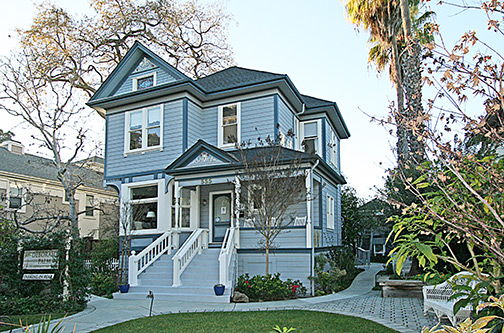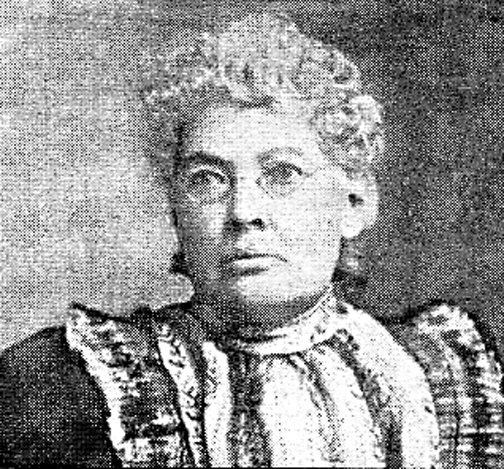 Palo Alto Stanford Heritage
Palo Alto Stanford Heritage  |
 |
| 555 Lytton Avenue (Krista van Laan photo) | Hannah Clapp |
There are few residences in Palo Alto that can claim as continuing a feminist pedigree as the Clapp house. Hannah Keziah Clapp (1824–1908) was a pioneer, educator and suffragist. At the age of 25, she moved from her birthplace near Albany, N.Y. to Michigan where she was first a teacher and then the principal of Lansing Female Seminary. By 1859, Hannah, sporting a holstered gun and wearing bloomers so that she could ride astride, embarked on a three month wagon train journey to California via Nevada.
After a year spent teaching in Vacaville, Clapp returned to the Nevada territory where she dedicated the next four decades to promoting education and suffrage. In 1861, Hannah founded a private co–educational school called the Sierra Academy, which educated a generation of Nevada’s leaders. The school’s success, aided by Clapp’s fundraising abilities, her propitious investment in the Belcher Mine and two visits from Mark Twain, necessitated the hiring of assistant principal Eliza Babcock. Among the results: Twain wrote about Hannah’s school in Tom Sawyer and Eliza and Hannah began a 35–year friendship. In 1877, Clapp and Babcock opened Nevada’s first kindergarten in the basement of Sierra Academy.
A move to Reno in 1883 was prompted by Clapp’s appointment as the first female professor teaching English and History at the University of Reno. In addition, Hannah managed the women’s dormitories and the school library, bringing the number of volumes in the latter from 50 to 6,000 within four years. During her Reno years, Clapp was a dedicated suffragist, working on four unsuccessful legislative efforts for voting rights and serving as vice president of the Nevada Equal Suffrage Association. She and Babcock also traveled widely, including a trip to Palo Alto, where, in 1890, they purchased property from Timothy Hopkins. They planned to retire some day to the house they would build on Lytton Avenue in 1896. Both Clapp and Babcock, as founding members of the 20th Century Club, Nevada’s first Woman’s Club persuaded that group to establish Reno’s first kindergarten in 1901. Unfortunately, Eliza died in 1899 and never saw Hannah spearhead the Babcock Memorial Kindergarten building campaign nor obtain the gratis design services of a former student, William Danforth Bliss, a noted San Francisco architect. Devastated by the loss of her friend, Hannah retired to 555 Lytton until her death in 1908.
The choice of Frank Delos Wolfe (1863–1926) to design and build their Queen Anne style house was fortuitous. He was known as the man to see in the South Bay if you wanted something special in a house. Alone or in partnership, Wolfe designed as many as 1,000 buildings in styles including Queen Anne, Craftsman, Neo–Classical, Prairie, Mission and Spanish Revival. Wolfe’s biographer, George Espinola, notes “Wolfe’s homes show an idiosyncratic mix of details from various styles and a courageous arrangement of windows, chimneys, roof lines and gables.” Born in Ohio to a long line of carpenter–builders, Frank Wolfe moved to San Jose with his wife, Nellie Crockett Wolfe, in 1888 after interning with Kansas architect W. I. Ross. Working first as a carpenter and builder, his flair for design encouraged him to open an architectural practice in 1895. He soon formed a partnership with Charles McKenzie that lasted until 1911.
The 1896 Queen Anne that Wolfe designed for Hannah Clapp followed the norms of that style, which dominated American architecture from 1890–1900. An asymmetrical façade is achieved with a steep, hipped roof that is intersected by a gable–roofed, square tower at the left and two intersecting hipped roofs at the sides. Delicate surface decoration is seen in the picture framing of a contrasting color which borders the clapboard siding, in the carved fleur de lis with roses inserts in the gable pyramids of the tower and the porch and in the beautifully colored attic window. The porch is approached by wide steps with a triple balustrade and is supported by turned spindle columns and decorative brackets. The most elaborate exterior decoration is reserved for the bay window. Its semi–hexagonal shape contrasts with the square tower and is dominated by a transomed picture window. Fluted oval panels, carved brackets and woodwork of a contrasting color frame it.
There could be no more fitting successor to Hannah Clapp than Kate Richey, who purchased this refined Queen Anne nine decades after Hannah’s death. Both the house and the non–profit organization which Richey founded are referred to as Deborah’s Palm. Its purpose is to offer a warm, welcoming environment to all women through professional counseling and access to resources, activities, classes, mentoring and community service projects. Hannah would be delighted.©
PAST, July 17, 2015
E-mail us at either webmaster@pastheritage.org or president@pastheritage.org.
![]() Palo Alto Stanford Heritage—Dedicated to the preservation of Palo Alto's historic buildings.
Palo Alto Stanford Heritage—Dedicated to the preservation of Palo Alto's historic buildings.
Copyright © 2015 Palo Alto Stanford Heritage. All rights reserved.